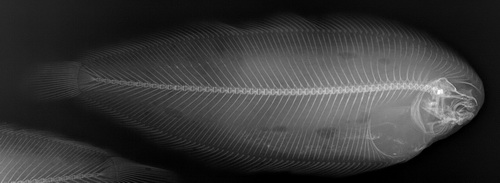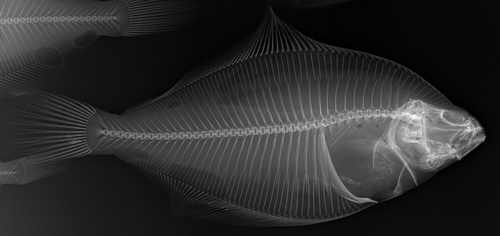Projekt
Modelling the effects of electrical pulse stimulation on marine fishes and invertebrates
We study the effects of electrical pulse stimulation on various marine organisms in the context of electric pulse bottom trawl fisheries.
Fishing with electricity is an experimental fishing method currently used by bottom trawlers in the southern North Sea based on derogations (Council of the European Union, 2005 & 2006; Rijksoverheid, 2014; Rijnsdorp, Rasenberg & Wilms, 2014), since the use of electricity for catching marine organisms is prohibited within the European Union (Council of the European Union, 1998). This so-called electric pulse bottom trawling (short: pulse trawling) is a fishing technique in which electrical pulses are used to stimulate the target species from sediment (Boonstra & de Groot, 1974; Soetaert, 2015). Depending on the pulse gear type (and fishing boat type), either common sole (Solea solea) or brown shrimp (Crangon crangon) are targeted by the fishermen (Soetaert, 2015; Desender et al., 2016). Pulse trawling has numerous advantages over conventional tickler chain beam trawling during which heavy tickler chains plough the seabed (Soetaert, 2015). Fuel consumption may be cut by 50%, fish discards may be reduced up to 57%, and benthic discards up to 80% (van Marlen et al., 2014). In addition, higher survival rates of undersized European plaice (Pleuronectes platessa), dab (Limanda limanda), and common sole were found by van der Reijden et al. (2017). Higher selectivity, reduced seabed damage, and higher net revenues make electric pulse trawling a promising, more sustainable, alternative compared to the conventional fishing method (e.g. van Marlen et al., 2014; Soetaert, 2015; Depestele et al., 2016). However, serious concerns have been raised by various stakeholders (e.g. EU member states, fishing industry, and NGOs) regarding the introduction of pulse trawling in the North Sea. These include the lack of knowledge about ecological effects of electrical pulses on the marine ecosystem, the risk of increased catch efficiency, and the consequences for other fisheries (e.g. Quirijns et al., 2013 & 2015; Kraan, Trapman & Rasenberg, 2015; Haasnoot, Kraan & Bush, 2016; Rijnsdorp et al., 2016; Steins et al., 2017). In addition, concerns regarding possible adverse effects on size classes and species that are not retained and/or are in the neighbourhood of the electric fields are present.
Es tut uns leid, Ihre Cookie-Einstellungen sind so gesetzt, dass das Video nicht angezeigt werden kann. Jetzt einstellen
In this report, concerns of various aspects of the introduction of pulse fishing are described (by James Clayton for BBC Newsnight).
The “Impact Assessment Pulse Fishery” (IAPF) project was developed and aims to investigate the effect of pulse fishing on marine organisms, benthic geochemistry and ecosystem, fish stocks, and bycatch of undersized fish at the scale of the North Sea. Within the IAPF project, we are responsible for developing the required insight and tools to assess effects of electric flatfish pulse fishing on marine fishes and benthic invertebrates. We aim to assess this by constructing a quantitative framework by combining numerical simulations of the electric field with laboratory experiments on a range of species, which allows generalisation to other fish and invertebrate species. In addition, we sample the catches from flatfish pulse fishing vessels to map injuries in various fish species.
We offer a range of opportunities for BSc and MSc students to participate within this project. If you are a motivated student and interested in this project, please contact Pim Boute and Martin Lankheet via email to discuss the possibilities.





Radiographs of fishes caught by pulse trawling (made by Remco P.M. Pieters). From top-to-bottom: common sole (Solea solea), dab (Limanda limanda), whiting (Merlangius merlangus), grey gurnard (Eutrigla gurnardus), and great sandeel (Hyperoplus lanceolatus).
Our main collaborators within the “Impact Assessment Pulse Fishery” (IAPF) project are: Justin C. Tiano MSc. and prof. dr. Karline Soetaert (Royal Netherlands Institute of Sea Research, the Netherlands), dr. Hans Polet (Institute for Agricultural and Fisheries Research, Belgium), dr. Jan Jaap Poos, Dick de Haan, ir. Edward Schram, and dr. Adriaan D. Rijnsdorp (IAPF project leader) (Wageningen Marine Research, the Netherlands).
Es tut uns leid, Ihre Cookie-Einstellungen sind so gesetzt, dass das Video nicht angezeigt werden kann. Jetzt einstellen
In this short film the state of play of pulse fishing is set out (by the Ministry of Economic Affairs of the Netherlands). Fishermen, scientists and non-governmental organisations explain their opinion on pulse fisheries.
This PhD project is part of the “Impact Assessment Pulse Fishery" project, which is commissioned by the Dutch Ministry of Agriculture, Nature and Food Quality (previously by the Dutch Ministry of Economic Affairs) and financed through the Dutch component of the European Maritime and Fisheries Fund (EMFF). Visit “Dossier pulse fishing” for more information regarding the research, news, and publications on pulse fishing by Wageningen University & Research. Visit "Pulse Fishing" regarding current and past research on pulse trawling and the latest information on catches, discards, ecosystem effects, and economic viability in relation to the use of pulse trawling.


References
Boonstra, G.P. & de Groot, S.J. (1974). The development of an electrified shrimp-trawl in the Netherlands. ICES Journal of Marine Science. Vol. 35(2): 165–170. (doi:10.1093/icesjms/35.2.165)
Depestele, J., Ivanović, A., Degrendele, K., Esmaeili, M., Polet, H., Roche, Summerbell, K., Teal, L.R., Vanelslander, B., O'Neill, F.G. (2016). Measuring and assessing the physical impact of beam trawling. ICES Journal of Marine Science. Vol. 73(Suppl. 1): i15–i26. (doi:10.1093/icesjms/fsv056)
Desender, M., Chiers, K., Polet, H., Verschueren, B., Saunders, J. H., Ampe, B., Mortensen, A., Puvanendran, V., Decostere, A. (2016). Short-term effect of pulsed direct current on various species of adult fish and its implication in pulse trawling for brown shrimp in the North Sea. Fisheries Research. Vol. 179: 90–97. (doi:10.1016/j.fishres.2016.02.018)
Council of the European Union (1998). Council Regulation (EC) No 850/98 of 30 March 1998 for the conservation of fishery resources through technical measures for the protection of juveniles of marine organisms. OJ L 125, 27.4.1998: 36p.
Council of the European Union (2005). Council Regulation (EC) No 51/2006 of 22 December 2005 fixing for 2006 the fishing opportunities and associated conditions for certain fish stocks and groups of fish stocks, applicable in Community waters and, for Community vessels, in waters where catch limitations are required. OJ L 16, 20.1.2006: 183p.
Council of the European Union (2006). Council Regulation (EC) No 41/2006 of 21 December 2006 fixing for 2007 the fishing opportunities and associated conditions for certain fish stocks and groups of fish stocks, applicable in Community waters and, for Community vessels, in waters where catch limitations are required. OJ L 15, 20.1.2007: 213p.
Haasnoot, T., Kraan, M. & Bush, S.R. (2016). Fishing gear transitions: lessons from the Dutch flatfish pulse trawl. ICES Journal of Marine Science. Vol. 73(4): 1235–1243. (doi:10.1093/icesjms/fsw002)
van Marlen, B., Wiegerinck, J.A.M., van Os-Koomen, E., van Barneveld, E. (2014). Catch comparison of flatfish pulse trawls and a tickler chain beam trawl. Fisheries research. Vol. 151: 57–69. (doi:10.1016/j.fishres.2013.11.007)
Quirijns, F., Strietman, W.J., van Marlen, B., Rasenberg, M. (2013). Flatfish pulse fishing. Research results and knowledge gaps I. IMARES Wageningen UR, Report C193/13. 25p.
Quijrijns, F., Strietman, W.J., van Marlen, B., Rasenberg, M., Smith, S.R. (2015). Flatfish pulse fishing. Research results and knowledge gaps II. IMARES Wageningen UR, Report C091/15. 39p.
van der Reijden , K.J., Molenaar, P., Chen, C., Uhlmann, S.S., Goudswaard, P.C., van Marlen, B. (2017). Survival of undersized plaice (Pleuronectes platessa), sole (Solea solea), and dab (Limanda limanda) in North Sea pulse-trawl fisheries. ICES Journal of Marine Science. Vol. 74(6): 1672–1680. (doi:10.1093/icesjms/fsx019)
Rijksoverheid (2014). Agreement to double pulse trawl licenses. News item, 18-02-2014, 16:45, Ministry of Economic Affairs. [last accessed 17 September 2017]
Rijnsdorp, A.D., Rasenberg, M.M.M. & Wilms, I. (2014). Proposal for pulse trawl research. North Sea Advisory Council (NSAC), Focus group pulse trawl 17-11-2014, IJmuiden. 7p.
Rijnsdorp, A.D., de Haan, D., Smith, S., Strietman, W.J. (2016). Pulse fishing and its effects on the marine ecosystem and fisheries An update of the scientific knowledge. Wageningen University & Research, Report C117/16. 32p.
Soetaert, M. (2015). Electrofishing: exploring the safety range of electric pulses for marine species and its potential for further innovation. Doctoral thesis. Faculty of Veterinary Medicine, Department of Pathology, Bacteriology and Avian Diseases, Ghent. 243p.
Steins, N.A., Smith, S., Strietman, W.J., Trapman, B., Kraan, M. (2017). International Stakeholder Dialogue on Pulse Fisheries; Report of the second dialogue meeting, Amsterdam 20 January 2017. Wageningen Marine Research, Wageningen University & Research. Report number C016/17. 145p.